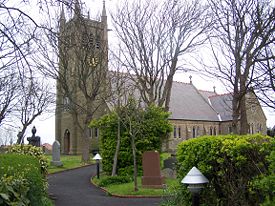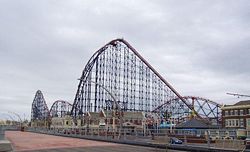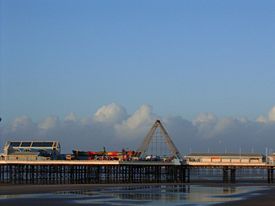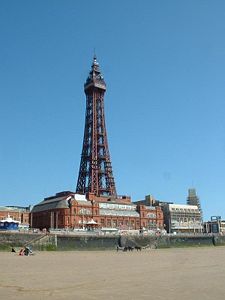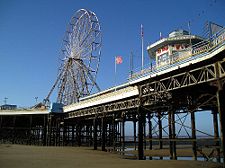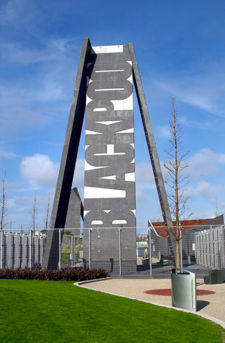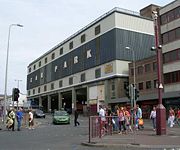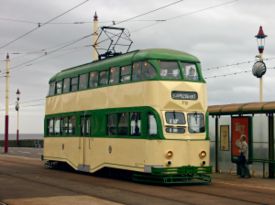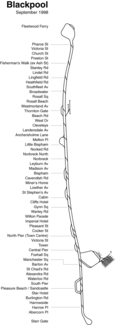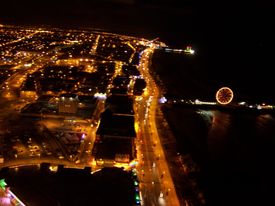Blackpool
2008/9 Schools Wikipedia Selection. Related subjects: British Cities; Great Britain
| Blackpool | |
 Blackpool 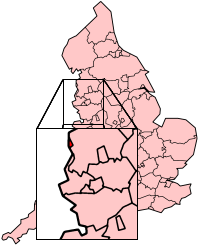 Shown within England |
|
| Geography | |
|---|---|
| Status: | Borough, Unitary Authority (1998) |
| Region: | North West England |
| Admin. County: | Lancashire |
| Area: Total: |
Ranked 330th 34.92 km² |
| Admin. HQ: | Blackpool |
| ONS code: | 00EX |
| Demographics | |
| Population: Total (2006 est.): Density: |
Ranked 122nd 142,700 4086 / km² |
| Ethnicity: | 96.8% White 1.3% Asian 0.8% Mixed 0.4% Black 0.3% Chinese 0.2% Other Estimate |
| Politics | |
|
Blackpool Council http://www.blackpool.gov.uk/ |
|
Blackpool ( /ˈblækˌpul/ ) is a seaside town in Lancashire, England. Lying along the coast of the Irish Sea, it has a population of 142,900, making it the fourth-largest settlement in North West England.
Blackpool rose to prominence as a major centre of tourism during the 19th century, particularly for the inhabitants of northern mill towns.
History
Toponymy
Blackpool is believed to get its name from a historic drainage channel (possibly Spen Dyke) that ran over a peat bog, discharging discoloured water into the Irish Sea, which formed a black pool (on the other side of the sea, Dublin is derived from the Irish for "black pool"). Another explanation is that the local dialect for stream was "pul" or "poole", hence "Black poole".
People originating from Blackpool are called "Sand Grown" or "Sandgrown'uns".
Early history
A 12,000 year old animal skeleton (the Carelton Elk) found with barbed arrowheads near Blackpool Sixth Form College in 1970 provided the first evidence of humans living on the Fylde as far back as the Palaeolithic era. The Fylde was also home to a British tribe, the Setantii (the "dwellers in the water") a sub-tribe of the Brigantes, who from about AD80 were controlled by Romans from their fort at Dowbridge, Kirkham. During the Roman occupation the area was covered by oak forests and bog land.
Some of the earliest villages on The Fylde, which were later to become part of Blackpool, were named in the Domesday Book in 1086. Many of them were Anglo-Saxon settlements. Some though were 9th and 10th century Viking place names. The Vikings and Anglo Saxons seem to have co-existed peacefully with some Anglo Saxon and Viking place names later being joined together - such as Layton-with-Warbreck and Bispham-with-Norbreck. Layton was controlled by the Butlers, Barons of Warrington from the 12th century.
In medieval times Black Poole emerged as a few farmsteads on the coast within Layton-with-Warbreck. The name coming from "le pull" which was a stream that drained Marton Mere and Marton Moss into the sea close to what is now Manchester Square. The stream ran through peat lands which discoloured the water, and so the name for the area became Black Poole. In the 15th century the area was just called Pul. And a 1532 map calls the area "the pole howsys alias the north howsys”.
In 1602, entries in Bispham Parish Church baptismal register include both Poole and for the first time blackpoole. The first house of any substance, Foxhall, was built toward the end of the 17th century by Edward Tyldesley, the Squire of Myerscough, and son of the Royalist, Sir Thomas Tyldesley. An Act of Parliament in 1767 enclosed a common, mostly Sand Hills on the coast, that stretched from Spen Dyke southward. And plots of the land were allocated to landowners in Bispham, Layton, Great Marton and Little Marton. The same Act also provided for the layout of a number of long straight roads that would be built such as Lytham Road, St.Annes Road and Highfield Road.
Taking the Cure
By the middle of the 18th century, the practice of sea bathing to cure diseases was beginning to become fashionable among the wealthier classes, and visitors began making the arduous trek to Blackpool for that purpose. In 1781 Thomas Clifton and Sir Henry Hoghton built a private road to Blackpool, and a regular stagecoach service from Manchester and Halifax was established. A few amenities, including four hotels, an archery stall and bowling greens, were developed, and the town grew slowly. The 1801 census records the town's population at 473. The growth was accelerated by the actions of Henry Banks, often considered to be the “Father of Blackpool”. In 1819 he purchased the Lane Ends estate, including the Lane Ends Hotel and built the first holiday cottages. In 1837, his son-in-law Dr. John Cocker built Blackpool’s first assembly rooms, which still stand on the corner of Victoria Street and Bank Hey Street.
Arrival of the railway
The most significant event in the early growth of the town occurred in 1846, with the completion of a branch line to Blackpool from the main Preston and Wyre Joint Railway line from Preston to Fleetwood. Fleetwood declined as a resort, as its founder and principal financial backer, Peter Hesketh-Fleetwood went bankrupt. In contrast, Blackpool boomed. A sudden influx of visitors provided the motivation for entrepreneurs to build accommodations and create new attractions, leading to more visitors and a rapid cycle of growth throughout the 1850s and 1860s. In 1851 a Board of Health was formed. Gas lighting was introduced in 1852, and piped water in 1864. By 1851, the town's population was over 2500.
The growth was intensified by the practice among the Lancashire cotton mill owners to close the factories for a week every year to service and repair machinery. These became known as Wakes Weeks. Each town's mills would close for a different week, allowing Blackpool to manage a steady and reliable stream of visitors over a prolonged period in the summer.
In 1863, the North Pier was completed, rapidly becoming a centre of attraction for elite visitors. Central Pier was completed in 1868, with a theatre and a large open-air dance floor. The town expanded southward beyond what is today known as the Golden Mile, towards South Shore, and South Pier was completed in 1893, making Blackpool the only town in the United Kingdom with three piers. In 1878, the Winter Gardens complex opened, incorporating ten years later the Opera House theatre, said to be the largest in Britain outside of London.
The town was granted a Charter of Incorporation as a Municipal borough in 1876. W.H. Cocker, son of Dr John Cocker, and therefore grandson of Henry Banks, was its first mayor. The town would become a County Borough in 1904.
Electricity
Much of Blackpool's growth and character from the 1870s on was predicated on the town's pioneering use of electrical power. In 1879, it became the first municipality in the world to have electric street lighting, as large parts of the promenade were wired. The lighting and its accompanying pageants reinforced Blackpool's status as the North's most prominent holiday resort, and its specifically working class character. It was the forerunner of the present-day Blackpool Illuminations. In 1885 one of the world's first electric tramways was laid down as a conduit line running from Cocker Street to Dean Street on the Promenade. The line was operated by the Blackpool Electric Tramway Company until 1892 when their lease expired and Blackpool Corporation took over running the line. A further line was added in 1895 from Manchester Square along Lytham Road to South Shore, and the line was extended north, first to Gynn Square in 1899, and then to Fleetwood. The tramway has remained in continuous service to this day.
By the 1890s, the town had a population of 35,000, and could accommodate 250,000 holidaymakers. The number of annual visitors, many staying for a week, was estimated at three million. 1894 saw the opening of two of the town's most prominent buildings; the Grand Theatre on Church Street, and Blackpool Tower on the Promenade.
The first decade of the new century saw the development of the Promenade as we know it today, and further development southwards beyond South Shore towards Harrowside and Squires Gate. The Pleasure Beach was first established about this time. Seasonal static illuminations were first set up in 1912, although due to World War I and its aftermath, they only enjoyed two seasons until they were re-introduced in 1925. The illuminations extended the holiday season into September and October.
Towards the Present
The inter-war period saw Blackpool attain pre-eminence as a holiday destination. By 1930, Blackpool claimed around seven million visitors per year, three times as many as its nearest British rivals, still drawn largely from the mill towns of East Lancashire and West Yorkshire. Stanley Park was laid out in 1920 and opened in 1926. The area round the park has become renowned for some of the most desirable residences in the area.
Blackpool was spared serious damage during World War II, and in the decade afterwards, it continued to attract more visitors, reaching a zenith of 17 million per year. However, several factors combined to make this growth untenable. The decline of the textile industry led to a de-emphasis of the traditional week-long break. The rise of package holidays sent many of Blackpool's traditional visitors abroad, where the weather was more reliably warm and dry, and improved road communications, epitomized by the construction of the M55 motorway in 1975, made Blackpool more feasible as a day trip rather than an overnight stay. The economy, however, remains relatively undiversified, and firmly rooted in the tourism sector.
Local Government
Though the Blackpool Urban Area extends beyond the statutory boundaries of Blackpool to encompass Fleetwood, Cleveleys, Thornton, Poulton-le-Fylde and Lytham St Anne's, Blackpool remains administratively separate.
Between 1894 and 1974, Blackpool formed a county borough independent of the administrative county of Lancashire. With the passage of the Local Government Act 1972, Blackpool's county borough status was abolished and it was made part of the shire county of Lancashire. On April 1, 1998, however, Blackpool was made a unitary authority and re-formed as an autonomous local government unit. It remains part of Lancashire for ceremonial purposes however.
As of 2008 Blackpool council is currently controlled by the Conservative party the largest party represented with 27 councillors and a governmental majority of 12. The Labour party with over 12 councillors and the Liberal democrats with just 3 the third and fourth largest parties represented respectively are currently in opposition.
| Year | Conservatives | Labour | Liberal Democrats | |
|---|---|---|---|---|
| 2008 | 27 | 12 | 3 |
Tourism
Blackpool is heavily dependent on tourism. In what is often regarded as its heyday (1900-1950), Blackpool thrived as the factory workers of northern England took their annual holidays there en masse. Any photograph from that era shows crowds of tourists on the beach and promenade. Blackpool was also a preferred destination of visitors from Glasgow and remains so to this day . Reputedly, the town still has more hotel and B&B beds than the whole of Portugal. The town went into decline when cheap air travel arrived in the 1960s and the same workers decamped to the Mediterranean coast resorts due to competitive prices and the more reliable weather. Today Blackpool remains the most popular seaside resort in the UK, however the town has suffered a serious drop in numbers of visitors which has fallen from 17 million in 1992 to 10 million today. Similarly Blackpool Pleasure Beach remains the country's most popular free attraction with 6 million visitors a year but has lost over a million visitors since 1998. Today, many visitors stay for the weekend rather than for a week at a time.
Conferences
Outside the main holiday season, Blackpool's Winter Gardens routinely hosts major political and trade union conferences, ranging from that of the Conservative Party and the TGWU with thousands of delegates and visitors, to substantially smaller gatherings such as the CWU or NUS conferences.
Entertainment
Blackpool remains a summer entertainment venue, specialising in variety shows featuring entertainers such as Ken Dodd and Roy 'Chubby' Brown
Events and festivals
- Blackpool Dance Festival is a world famous annual ballroom dance competition of international significance:
- Blackpool Illuminations consisting of a series of lighted displays and collages arranged along the entire length of the sea front, seven miles (11 km) in total, attract many visitors from late August to early November; a time when most British seaside resorts' holiday seasons have already ended. This results in some spectacular traffic snarl-ups as most people now view the lights from cars and coaches which crawl nose-to-tail along the whole length of the sea front, particularly so at weekends and during school holidays. Each season a famous person "flicks the switch" to turn the lights on in an opening night Switch on ceremony. Scottish actor David Tennant flicked the switch for the 2007 display on 31 August.
Gay Blackpool
Blackpool has often been described as the "gay capital of the North" (with Brighton often being described as "the gay capital of the South"). Historically, seaside resorts have been able to provide niches for minority groups. Blackpool, like other English resorts, has had a reputation for being a safe community for gay people. During the second world war, there was a proliferation of cafés, pubs and clubs where homosexual men could meet in Blackpool. In the 1990s, the town began to be promoted as a gay tourist destination.
Blackpool contains several bars, pubs and nightclubs aimed at the LGBT community. These include Funny Girls (a burlesque cabaret showbar), FG2, the Flamingo, the Flying Handbag, Lucy's Two, Pepe's, Roxy's, Mardi Gras, Taboo and dtBar. There are two saunas catering for gay and bisexual men: Acqua Sauna Club and Honeycombe Sauna. The town had its first gay pride celebration in 2006.
Nightlife
Blackpool's modern night-life, like that of many other UK towns, has become increasingly dominated by "binge drinking". Blackpool has become a favoured destination for often roudy hen and stag parties (brides or bridegrooms-to-be and their friends) who roam the town's many bars and clubs getting increasingly drunk. Their behaviour and the character of the town at night is often claimed to have contributed to the decline of Blackpool as a family destination. Complaints have been raised from hotel and guest house owners keen to attract a more upmarket clientele.Such behaviour has also placed added strain on the town's emergency unit, based at the Victoria Hospital near Stanley Park. This is now one of busiest accident and emergency units in the country.
Future
Blackpool is continually striving to improve its position within today's tourist industry. One controversial proposal, which had the involvement of the local council, was to transform Blackpool into a casino resort along the lines of Las Vegas and Atlantic City, making it the centre point of gambling in the UK. However, Manchester was unexpectedly selected for the initial trial by the Government's Casinos Advisory Panel. Since this decision, Blackpool's council and MPs have lobbied Parliament extensively, claiming their bid was misunderstood. The local newspaper, the Blackpool Gazette, sent a petition signed by over 11,500 local residents and visitors demanding the decision be reconsidered. On 29 March 2007, the Advisory Panel's recommendations were approved by the House of Commons, but rejected by the House of Lords, meaning the bill must now be reconsidered by parliament. This has led many in the town to feel that Blackpool has been given a "second chance" to prove its' case, and as of April 2007, the town's representatives are still heavily lobbying parliament to award the casino to Blackpool.
Other future projects include a £500 m scheme to build Storm City a proposed multi-themed indoor entertainment complex on a 30 acre site between Rigby Road and Central Drive. Storm City would house:
- A 12,000 seated Arena
- Four World Class hotels
- Shopping areas
- Five themed entertainment areas
- Rooftop gardens
- Blackpool's own version of the London Eye.
In March 2007 Blackpool Council signed up to a three month deal to work exclusively with the developers of Storm City.
A second scheme, which is primarily aimed at the local population, but will also benefit those holidaymakers travelling to the town by rail, named Talbot Gateway would be a £285 m Civic Quarter, for which International project management specialist AMEC has been chosen to transform what is at present a rundown area around Blackpool North railway station into a what Blackpool Council hope will be a world class gateway with new office and retail space as well as a public square, dubbed the Talbot Plaza. The development would be 'wrapped' around Blackpool North railway station so that rail passengers arrive at street level into the new plaza with views down to the seafront, making their arrival at Blackpool a much more pleasant experience that at present. The regeneration company behind much of the towns current and future development, ReBlackpool are working with Blackpool Council and AMEC to sort out the planning application.
Landmarks & places of interest
Blackpool boasts some important landmarks, most of which appeared originally as part of the flourishing tourist industry.
Major attractions
- Blackpool Tower, opened in 1894; it has been a dominant landmark of the Blackpool skyline since that time. Inspired by the Eiffel Tower of Paris, France, it is 158 metres (518 ft 9 in) tall. Beneath the tower is a complex of leisure facilities, entertainment venues and restaurants, including the world famous Tower Ballroom and Tower Circus.
- North Pier - The northernmost of Blackpool's three piers. It includes a small shopping arcade, a small tramway and the North Pier Theatre toward the end of the pier. The pier end also used to have a helicopter pad, but this was damaged at Christmas 1997 by a windstorm and it collapsed into the Irish Sea.
- Central Pier - The middle pier, includes a large ferris wheel and shops.
- South Pier - The southernmost pier. Almost directly opposite the Pleasure Beach, it houses a theme park.
- Pleasure Beach Blackpool - a famous theme park. Rides include the Pepsi Max Big One, which was the world's fastest and tallest complete circuit rollercoaster between 1994 and 1996.
- The Winter Gardens is a large entertainment and conference venue in the town centre. Includes the Opera House (one of the largest theatres in Europe), Pavilion Theatre, Empress Ballroom, Spanish Hall, Arena and Olympia.
Other attractions
- Beach - Stretching along the whole seafront. The main natural attraction for tourists.
- Funny Girls - World Famous Drag Cabaret Burlesque Showbar, located on the North Shore.
- Blackpool Zoo - provides a home to over 1500 animals from all over the world.
- Grand Theatre - Victorian theatre designed by Frank Matcham. Also now known as the National Theatre of Variety.
- Great Promenade Show - Series of modern artwork installations along Blackpool's South Promenade. Includes the Blackpool High Tide Organ an unusual musical monument which uses the movements of the sea to make music.
- Louis Tussaud's Waxworks - Waxwork Museum, featuring models of celebrities, musicians, sports personalities and the famous Chamber of Horrors.
- Doctor Who Exhibition The Biggest Doctor Who Exhibition in the UK - contains props and costumes from the long-running BBC TV series, including some from recently aired programmes.
- Sandcastle Water Park (now known as Waterworld) - An indoor swimming pool with slides and waves. Next to the South Pier.
- Stanley Park - Grade II Historic Park & Gardens with Golf Course, Cricket Club, Sports Arena, Lake, Art Deco Restaurant, Model Village, Gardens, etc.
- Odeon Cinema - Situated on a multi-complex site, on Rigby Road, with 10 screens.
- The Syndicate Superclub, holds just over 5,000 people.
Tall Structures in Blackpool
| Building | Height (ft) | Height (m) | Floors |
|---|---|---|---|
| Blackpool Tower | 518 | 158 | |
| Pepsi Max Big One | 213 | 65 | N/A |
| Walter Robinson Court | 210 | 64 | 22 |
| Ice Blast | 210 | 64 | N/A |
| Charles Court | 150 | 46 | 16 |
| Churchill Court | 150 | 46 | 16 |
| Elizabeth Court | 150 | 46 | 16 |
| Ashworth Court | 150 | 46 | 16 |
Transport
Air
Blackpool International Airport operates regular charter and scheduled flights throughout the UK and Europe. The airport is actually just over the borough boundary into Fylde Borough, although a proposal to reorganise Blackpool's borders would see the airport incorporated into Blackpool Borough. This airport which was formerly known as Blackpool Squires Gate Airport, is one of the oldest in the UK and has been in use as an airfield since 1909. Airlines serving Blackpool include Jet2 and Ryanair.
In 1927 the local council announced that an aerodrome would be built near Stanley Park, which would become Blackpool Stanley Park Airport offering flights to the Isle of Man for £1.80. The airport was officially opened by then British Prime Minister, Ramsay MacDonald in 1931. However, with the opening of Squires Gate Airport a decision was made in 1936 by the Ministry of Transport to close the airport at Stanley Park. The airport closed a year later. During the Second World War the airport was used as a Royal Air Force training station, known as No. 3 School of Technical Training. The land that the airport stood on now covers Blackpool Zoo as well as a hotel and golf course. The hangars from the old airport are still in use as the elephant enclosure for the zoo.
Bus and coach
Busses and coaches are operated by:
- Blackpool Transport operates the main bus services in and around Blackpool, under the operational name of Metro Coastlines.
- Stagecoach operates the regional bus and coach services in and out of Blackpool, under the operational name of Stagecoach in Lancashire or Stagecoach Express.
- National Express operates the main long distance coach services in and out of Blackpool.
Facilities include -
- Blackpool Talbot Road Bus Station which was the main town centre bus station, but is now used by Stagecoach and National Express services, and is officially called Blackpool National Express Coach Station. Blackpool Transport stopped using the bus station in the early 2000s after a disagreement with Blackpool Council regarding the state of the bus station building. Blackpool Transport now use Market Street and Corporation Street as their bus interchange which is located in the heart of the town centre.
- Blackpool Lonsdale Road Coach Station the main coach station in Blackpool, is located in South Shore. This is mainly used by independent coach operators and also by some National Express services. The coach station has a cafe, shop and toilet facilities but is in a state of disrepair.
- Blackpool Colosseum Bus & Coach Station was the main bus and coach station in South Shore. Located next to Blackpool Transport Headquarters, it was demolished to make way for a Somerfield supermarket.
Railway
Train operators serving Blackpool include:
- Northern
- TransPennine Express
Stations in the town are, or were:
- Blackpool North (originally Talbot Road)
- Blackpool Pleasure Beach
- Blackpool South (originally Waterloo Road)
- Layton (originally Bispham)
- Squires Gate (just outside the borough boundary but serving Blackpool International Airport)
- Blackpool Central (originally Hounds Hill, closed 1964)
- Burlington Road Halt (closed 1949)
- South Shore (renamed Lytham Road 1903, closed 1916)
Blackpool once had two railway termini with a total of over 30 platforms, mainly used by excursion traffic in the summer. Blackpool Central, close to Blackpool Tower, was closed in 1964, whilst Blackpool North was largely demolished and rebuilt as a smaller facility. The route of the former excursion line into Blackpool Central is now used as a link road from the M55 motorway to the town centre. The line into Blackpool via Lytham St Annes now has a station serving Blackpool Pleasure Beach but terminates at Blackpool South station. The line into North station is now the more important.
Road
The M55 motorway links the town to the national motorway network.
Tram
Blackpool tramway runs from Starr Gate in Blackpool to Fleetwood and is the only surviving first-generation tramway in the United Kingdom (UK). The tramway dates back to 1885 and is one of the oldest electric tramways in the world. It is run by Blackpool Transport as part of the Metro Coastlines, owned by Blackpool Council. The tramway runs for 11 miles and carries 6,500,000 passengers each year.
The tramway was for a long time the only working tramway in the United Kingdom (UK) outside of museums. It was also the UK's first electric system. However there are now a number of other tramways including Manchester Metrolink, South London Tramlink and Sheffield Supertram.
On 1 February 2008 it was announced that the Government had agreed to a joint Blackpool Transport and Blackpool Council bid for funding toward the total upgrade of the track. The government will contribute £60.3M of the total £85.3 m cost. Both Blackpool Council and Lancashire County Council will each provide about £12.5M. The Government's decision means that the entire length of the tramway from Starr Gate to Fleetwood will be upgraded and also sixteen state-of-the-art trams will replace the current fleet.
Filmography
The resort is featured in the 1934 film Sing as We Go, starring Gracie Fields, as well as other cinema and TV productions, including Hindle Wakes (1952) and Funny Bones (1995) starring Lee Evans and Oliver Platt and directed by St. Annes born Peter Chelsom, as well as The Parole Officer (2001) starring Steve Coogan.
The Japanese film Shall We Dance (1996) closes with a scene at the World Ballroom Dancing Championships in Blackpool. All the hair styling for the film was completed by Blackpool born and bred hairstylist Eileen Clough, who has been in the trade since the 1960s. In the Hollywood remake of the film (2004) Blackpool is mentioned but not shown. The remake was also directed by Peter Chelsom.
Blackpool is the setting for Bhaji on the Beach (1993) directed by Gurinder Chadha. The film Like It Is (IMDB) (1998) directed by Paul Oremland was also partly filmed in Blackpool. The opening scenes were filmed in the Flamingo. The 2005 television comedy/thriller series Funland revolved around the fictionalized, seedier aspects of Blackpool.
Rick Steves' Europe introduced the viewer to the resort, explaining the history and its attractions.
The town also features heavily in the BBC television serial Blackpool starring David Morrissey, Sarah Parish and David Tennant, first broadcast in 2005 along with the one-off follow-up Viva Blackpool, broadcast in June 2006.
Music
Blackpool was notorious for having imposed an indefinite ban on the Rolling Stones from performing in the town in 1964 after a riot broke out among the audience who had found their performance suggestive during their concert at the Empress Ballroom. The ban was lifted forty-four years later in March 2008.
The Jimi Hendrix - Experience video and DVD features concert footage of Hendrix's performance at Blackpool's Opera House in 1967.
Sport
Boxing
The Tower Circus Arena held regular professional boxing shows for a number of years. However, for many years boxing shows have been few and far between in the town, with events being promoted on an irregular basis including one in 2005 at the Hilton hotel. However, on 16 February 2008 professional boxing returned to the 2,000 capacity Tower Circus Arena. The show is to be filmed by Manchester television company Channel M for screening on 1 March.
Cricket
Blackpool Cricket Club. They last won the League Cup in 2005, and were National Champions in 1990. Also between 1973-1996, they won the Lancashire Cup on eight occasions and were League Champions fourteen times. Their home is in the grounds of Stanley Park.
Football
Blackpool Football Club, also sometimes known as the Seasiders or the Tangerines, is the town's professional football club. Their most notable achievement was winning the 1953 FA Cup Final.
The club's stadium is Bloomfield Road, which is currently being redeveloped and modernised in stages.
Several professional footballers were either born in the town or have lived there. These include:
- Jimmy Armfield - former captain of Blackpool and England; still lives in the town.
- Dave Durie - born in the town; played over 300 league games for Blackpool in the 1950s and '60s.
- George Eastham - born in the town.
- Herbert Jones - born in the town; later won six caps for England.
- Matty Kay - born in the town; youngest player to make Blackpool F.C.'s first team.
- Gavin McCann - born in the town.
- Joe Smith - Blackpool F.C.'s longest-serving manager; lived and died in the town.
Other football clubs in Blackpool:
- Blackpool Mechanics Football Club. Also sometimes known as the "Mechs". Their home ground is Jepson Way.
- Blackpool Wren Rovers Football Club. Their home ground is Bruce Park.
- Blackpool Wren Rovers Ladies Football Club.
- Squires Gate Football Club. Their home ground is School Road.
Rugby League
Blackpool Panthers Rugby League Football Club. Their home ground is Woodlands Memorial Ground in the neighbouring town of Lytham St Annes, which is also the home to Fylde Rugby Union Football Club
Rugby Union
Blackpool Rugby Union Football Club. Their home ground is Norbreck Rugby Ground.
Religion
Blackpool has a number of Christian churches. As well as eighteen Church of England and ten Roman Catholic churches there are also four Baptist, one Bible-Pattern Church Fellowship, one Christadelphian two Congregationalist, ten Methodist, one Elim Pentecostal, one Christian Scientist, one Unitarian and three United Reformed churches as well as two Salvation Army halls.
Other christian groups in the town include Blackpool Christian Centre, Blackpool Community Church, Kings Christian Centre, Liberty Church, part of the LGBT Christian Community connected to the Metropolitan Community Church and New Life Community Church.
The Keajra Kadampa Buddhist Centre is a residential Buddhist centre located in North Shore. A member of the New Kadampa Tradition - International Kadampa Buddhist Union.
The Central Mosque and Islamic Community Centre is located on Revoe Street providing prayer facilities for local Muslims as well as a community centre with kitchen and classrooms where Islamic education is taught to children.
Fylde Coast Hindu Society meet on the last Sunday each month.
Humanist
The Lancashire Secular Humanist group, based in Blackpool.
Jainism
There is a local Jain group in Blackpool.
The Blackpool Reform Jewish Congregation is located on Raikes Parade with a synagogue hall and classroom facilities; a purpose built sanctuary hall and assembly room. Blackpool United Hebrew Congregation is located on Leamington Road with a synagogue hall and community centre.
Mormonism
Church of Jesus Christ of Latter-Day Saints, Blackpool chapel.
The Quaker Friends meeting house is located on Raikes Parade with two meeting rooms.
There is a local group in Blackpool to cater for the small local Sikh community.
Spiritualism
Albert Road Spiritualist Church is located on Albert Road.
Blackpool Faith Forum
The Blackpool Faith Forum was established in 2001 in conjunction with Blackpool Council to provide interfaith dialogue between the various faith groups in the town, to raise awareness of the various faiths in the town and to promote a multifaith community. It is linked to the Interfaith Network of UK. In February 2007 a youth forum was established, Blackpool Faith Forum for Youth (BIFFY).
Shipwrecks
The coastline around Blackpool has been a graveyard to a number of vessels over the years. The most recent occurrence has been the grounding of the Riverdance in January, 2008. Famously, in 1897, HMS Foudroyant, Nelson's flagship prior to HMS Victory, was grounded close to North Pier in a storm.
Areas, districts and estates
|
|
|
Notable people
Blackpool has been the birthplace and home to many famous people, including:
- Ian Anderson - musician Jethro Tull
- Jo Appleby - soprano singer with Amici Forever
- Pat Astley - actress and porn star
- David Atherton - conductor
- David Ball - musician ( Soft Cell)
- Zoë Ball - English TV and radio presenter
- Ronnie Baxter - Darts player
- Lennie Bennett - comedian
- Charlie Cairoli - famous clown, born in Milan but became famous in Blackpool where lived from 1939 to his death in 1980
- George Carman - barrister
- Frank Carson - comedian
- Violet Carson - Coronation Street actress who played the part of Ena Sharples.
- Ronnie Clayton - British Featherweight Boxing Champion 1947-54, twice Lonsdale Belt winner
- Jimmy Clitheroe - British comedy actor, lived most of his life in North Shore, Blackpool, where he died in 1973
- Jenna-Louise Coleman - Emmerdale actress (Jasmine Thomas)
- Alistair Cooke - journalist and commentator
- Steve Croft - cricketer
- Raine Davison - actress
- John Evan - musician Jethro Tull
- Dan Forshaw - Jazz musician
- Jeffrey Hammond - musician Jethro Tull
- Roy Harper - musician
- Barney Harwood - TV presenter
- Edwin Hughes - ("Balaclava Ned") (1830-1927), the last survivor of the Charge of the Light Brigade at Balaklava in the Crimea lived in Blackpool and is buried there.
- John Inman - actor
- Augustus Kenderdine - landscape and portrait painter
- Cynthia Lennon - wife of John Lennon
- Jacqueline Leonard - actress
- Ian Levine - songwriter
- Syd Little - comedian, Little and Large
- Brian London - boxer
- Joe Longthorne - singer
- Chris Lowe - musician - ( Pet Shop Boys)
- Nick McCarthy - musician ( Franz Ferdinand)
- Stacey McClean - singer S Club 8
- Vic McGlynn - radio presenter
- John Mahoney - actor ( Frasier)
- Pauline Moran - actress
- Janet Munro - actress
- Graham Nash - ( The Hollies, Crosby, Stills & Nash (and Young))
- Bernadette Nolan - singer and actress
- Coleen Nolan - singer and TV presenter
- Chris Patten - politician and former Hong Kong governor
- Daryl Peach - World Pool Champion
- Jodie Prenger - singer and actress
- Maddy Prior - singer ( Steeleye Span)
- Peter Purves - TV presenter
- William Regal - ( WWE wrestler)
- John Robb - musician ( Goldblade), presenter, music critic
- Nikki Sanderson - actress Coronation Street
- Michael Smith - Nobel Prize-winning chemist
- Robert Smith - musician ( The Cure)
- Andy Summers - musician ( The Police)
- Frank Swift - footballer ( Manchester City and England)
- David Thewlis - actor ( Remus Lupin in the Harry Potter film series)
- Ricky Tomlinson - actor (Jim Royle in The Royle Family)
- Roger Uttley - rugby union player
- Daniel Whiston - ice skater ( Dancing on Ice)
- Shelly Woods - elite wheelchair athlete
Twin town
Blackpool is twinned with:
 Bottrop, Germany
Bottrop, Germany
